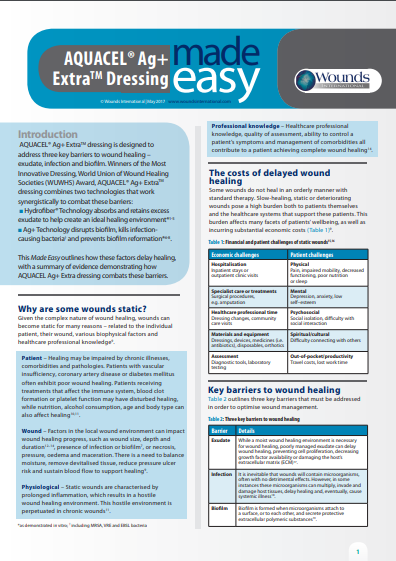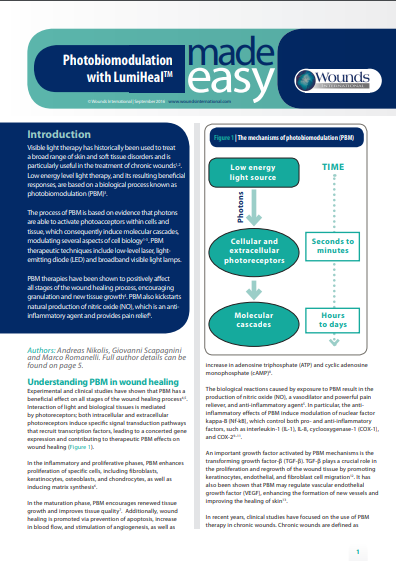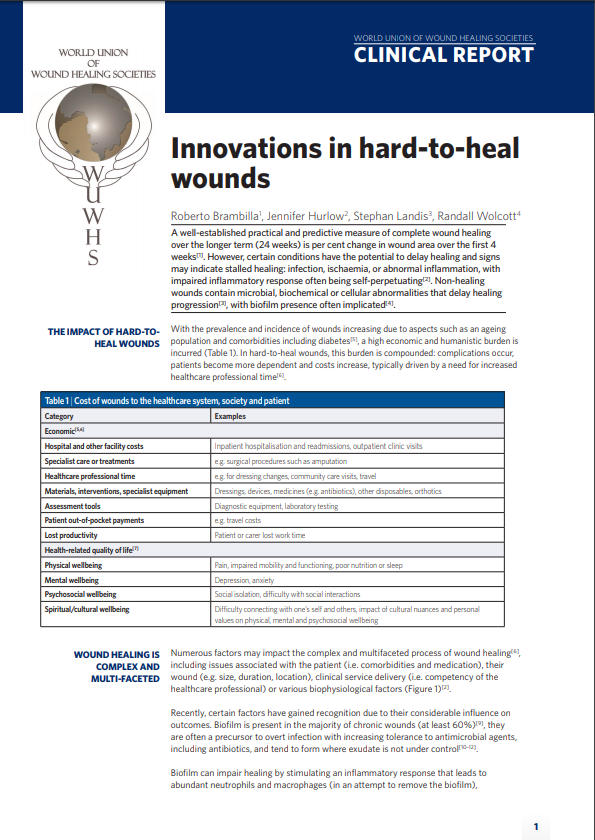Local management of Diabetic foot ulcers

The management of diabetic foot ulcers is complex, and requires a multi-disciplinary team approach to avoid serious and expensive complications, such as infection and amputation. This Quick Guide outlines the principles of local management and practice. Supported by Acelity
Closed surgical incision management:Understanding the role of NPWT

Substantial numbers of patients develop surgical site infections and other incisional complications worldwide each year. The social, healthcare and wider economic implications are considerable. As the average age of the population increases and multi-morbidity becomes more common, the number and complexity of surgical procedures performed is rising. As a result, reducing the risk and burden […]
Biofilm-based wound care with cadexomer iodine: Made Easy

Evidence suggests that biofilms are present in most, if not all, chronic, non-healing wounds with a recent in vivo study suggesting prevalence could be at least 78% (Malone et al, 2017a). This Made Easy informs clinicians about the role of cadexomer iodine, an effective anti-biofilm dressing, as an early intervention within the T.I.M.E (Schultz, 2003) […]
Improving outcomes in hard-to-heal wounds with single-use negative pressure: Part 1

This webcast, broadcast in October 2017 explores how implementing the PICO pathway in hard-to-heal wounds supports clinical decision making, improves patient outcomes, lowers the cost of treatment and reduces the cost burden on the health economy1. The first part of the webcast is presented by Caroline Dowsett, Clinical Nurse Specialist Tissue Viability, East London NHS […]
Improving outcomes in hard-to-heal wounds with single-use negative pressure: Part 2

This webcast, broadcast in October 2017 explores how implementing the PICO pathway in hard-to-heal wounds supports clinical decision making, improves patient outcomes, lowers the cost of treatment and reduces the cost burden on the health economy1. The second part of the webcast is presented by Jane Hampton, Consultant Wound Nurse, Aarhus Municipality, Denmark and focuses […]
Identification and management of infection in diabetic foot ulcers

Diabetic foot ulcers (DFUs) are rising in prevalence globally, and particularly in the Gulf region. Infection remains a common and serious complication in managing DFUs. A need was identified for local guidelines that considered cultural and religious practices in the Gulf region, as well as clinical issues. This consensus document aims to provide practitioners with […]
Making the case: BIOSORB Gelling Fibre Dressing

BIOSORBTM Dressing (Acelity) is a unique gelling fibre dressing, which is designed to manage exudate effectively and create an optimal environment for wound healing. When the absorbent dressing comes into contact with wound exudate, it forms a gel. This facilitates autolytic debridement and ensures that any wound debris retained in the fibre dressing is removed […]
Two-component compression: Concordance, evidence and clinical use

In the absence of corrective surgery, compression therapy has been found to be the most effective treatment for venous leg ulcers (VLUs) (Nelson et al, 2000; WUWHS, 2008; O’Meara et al, 2012). Achieving healing rests on patients’ adherence to treatment. However, a large body of evidence shows they do not always do so (Bland, 1996; […]
Hydrotherapy Made Easy-wint

Rapid cleansing, early granulation and sustained epithelialisation are important requirements for efficient chronic wound healing. This Made Easy discusses HydroTherapy, an innovative approach to wound treatment where a two-step therapy harnesses optimised hydration at all stages of the healing response to promote wound progression and healing. Supported by HARTMANN
AQUACEL® Ag+ Extra Made Easy

While there are a number of barriers to wound healing, addressing exudate, infection and biofilm is particularly important when managing slow-healing, static or deteriorating wounds. These barriers combine to increase the chronicity of a wound and must be tackled with innovative technologies that manage the microbial load and ensure an optimum moist wound healing environment. […]
Best Practice Guidelines: Skin and wound care in Epidermolysis Bullosa 2017

Epidermolysis bullosa (EB) describes a rare complex group of inherited skin fragility disorders. Ideally patients should be managed in a specialist centre. EB is a lifelong disorder that requires specialist intervention and considerations to minimise complications and improve quality of life. EB can be inherited autosomal recessively or autosomal dominantly; in general, recessive forms tend […]
Aquacel Extra dressing in practice: Quick Guide

This Quick Guide outlines how using a partnership of tried and tested AQUACEL dressings can provide effective wound management. The focus is on AQUACEL Extra dressing, which is designed to lock in harmful bacteria, micro-contour to the wound bed to maintain optimal moisture balance and reduce ‘dead space’ where bacteria can grow, and respond to […]
PHMB Made Easy

This Made Easy focuses on the challenge of dealing with infection, and how the use of polyhexamethylene biguanide (PHMB) can help. A new mode of delivery means that PHMB can now be delivered via foam dressing, combining the benefits of a traditional foam dressing with the antimicrobial properties of PHMB. Supported by Advanced Medical Solutions
Soring UAW Made Easy

Soring UAW is an effective tool for wound debridement that can be easily integrated into treatment pathways for various chronic wound aetiologies as an integral part of wound bed preparation. This Made Easy outlines this unique approach to debridement, describing how it works to protect healthy tissues at the wound site whilst targeting biofilm or […]
Making the Case: PROMOGRAN and PROMOGRAN PRISMA

There is an ever-increasing pressure to reduce costs in a challenged economy. However, a sole focus on the cost of dressings without thought for the total cost for a care ‘episode’ could represent a false economy, failing to consider long-term patient outcomes. Advanced wound dressings can help manage the wound environment, improve healing rates, reduce […]
WUWHS: Management of biofilm
Antimicrobial and multi-drug resistance loom large on the global healthcare landscape, in particular in the treatment of chronic, hard-toheal wounds where current figures put the presence of biofilm in 60%–100% of non-healing wounds. While the role that biofilm play in the chronicity of wounds is still in infancy, it is becoming widely accepted that hard-to-heal […]
WUWHS: Understanding Hidradenitis Suppurativa

Hidradenitis suppurativa is a chronic, disabling condition that often relentlessly progresses. Occurring in often otherwise healthy adolescents and adults, this rare disease manifests in painful lesions that may cause hypertrophic scars and immobility. Historically, it is often underdiagnosed because patients are embarrassed to seek help for the condition, which significantly impacts on daily life, physically, […]
WUWHS: Role of dressings in pressure ulcer prevention

Recognition of the huge economic, health-related and social burden of pressure ulcers has resulted in considerable efforts to reduce their occurrence. Despite this, pressure ulcers still occur. In recent years, evidence has been building that some types of dressings typically used to treat open wounds have the potential to supplement standard pressure ulcer prevention measures […]
Closed surgical incision management: Understanding the role of NPWT

Substantial numbers of patients develop surgical site infections and other incisional complications worldwide each year. The social, healthcare and wider economic implications are considerable. As the average age of the population increases and multi-morbidity becomes more common, the number and complexity of surgical procedures performed is rising. As a result, reducing the risk and burden […]
WUWHS: Innovations in hard-to-heal wounds
A well-established practical and predictive measure of complete wound healing over the longer term (24 weeks) is per cent change in wound area over the first 4 weeks. However, certain conditions have the potential to delay healing and signs may indicate stalled healing: infection, ischaemia, or abnormal inflammation, with impaired inflammatory response often being self-perpetuating. […]
WUWHS: Local management of Diabetic foot ulcers
Incidence of diabetes among the world’s adult population has almost quadrupled in the past 30 years with 422 million adults worldwide now diagnosed with the disease, according to the 2016 World Health Organization Global Diabetes Report. Within this population, the incidence of diabetic foot ulcers (DFUs) is reported to be 4%–10%, with a 1-in-4 risk […]
Case series evaluation: PROMOGRAN™ Protease Modulating Matrix and PROMOGRAN PRISMA™ Wound Balancing Matrix for non-healing wounds

This Wounds International case series evaluation presents seven case studies from five locations, illustrating use of PROMOGRAN Matrix and PROMOGRAN PRISMA Matrix in a range of wounds including diabetic foot wounds, leg ulcers, and atypical ulcers. All the wounds included in this study had stalled wounds, which had failed to heal within the expected timeframe. […]
IWII: Wound infection in clinical practice

This update provides an opportunity to explore contemporary advances in wound infection knowledge and practice. Since 2008, scientific and clinical understanding of chronic wound infection has developed significantly. In particular, awareness of the presence and impact of wound biofilm has advanced enormously; however, understanding of its pathogenesis is yet to be clarified fully. A holistic […]
BPA Made Easy

Although the mere presence of bacteria in chronic wounds may not indicate active infection or impaired healing, there is a point at which bacteria do begin to inhibit healing, which can result in local or even systemic infection. This point of pathogenicity is when the bacteria start to secrete proteases. This Made Easy discusses bacterial […]
BIOSORB™ Gelling Fibre Dressing in practice

While exudate is essential for moist wound healing, various problems can arise from excess exudate production. BIOSORB® Gelling Fibre Dressing has been designed for effectiveness at every stage of use – from application, throughout wear and on removal – with a focus on aspects of wound management affected by exudate, including: risk of maceration, comfort […]
Photobiomodulation with LumiHeal™ Made Easy

This Made Easy introduces LumiHeal, a novel photobiomodulation (PBM) treatment that incorporates an LED lamp and photoconverter gel. New studies indicate that PBM may be particularly useful in the treatment of chronic wounds, positively affecting all stages of the wound healing process and improving healing rates. Supported by Klox Technologies
Position document: Management of biofilm

Antimicrobial and multi-drug resistance loom large on the global healthcare landscape, in particular in the treatment of chronic, hard-toheal wounds where current figures put the presence of biofilm in 60%–100% of non-healing wounds. While the role that biofilm play in the chronicity of wounds is still in infancy, it is becoming widely accepted that hard-to-heal […]
Position document: Advances in wound care: the triangle of wound assessment

Wound assessment is complex and requires a range of clinical skills and knowledge. It has never been more important to challenge current assessment paradigms and extend our understanding of wound assessment beyond the wound edge. Supported by Coloplast
Position document: Local management of diabetic foot ulcers

Incidence of diabetes among the world’s adult population has almost quadrupled in the past 30 years with 422 million adults worldwide now diagnosed with the disease, according to the 2016 World Health Organization Global Diabetes Report. Within this population, the incidence of diabetic foot ulcers (DFUs) is reported to be 4%–10%, with a 1-in-4 risk […]
Position document: Understanding hidradenitis suppurativa

Consensus document: Role of dressings in pressure ulcer prevention

Recognition of the huge economic, health-related and social burden of pressure ulcers has resulted in considerable efforts to reduce their occurrence. Despite this, pressure ulcers still occur. In recent years, evidence has been building that some types of dressings typically used to treat open wounds have the potential to supplement standard pressure ulcer prevention measures […]
Consensus document: Closed surgical incision management: Understanding the role of NPWT

Substantial numbers of patients develop surgical site infections and other incisional complications worldwide each year. The social, healthcare and wider economic implications are considerable. As the average age of the population increases and multi-morbidity becomes more common, the number and complexity of surgical procedures performed is rising. As a result, reducing the risk and burden […]
Clinical report: Innovations in hard-to-heal wounds WUWHS

A well-established practical and predictive measure of complete wound healing over the longer term (24 weeks) is per cent change in wound area over the first 4 weeks. However, certain conditions have the potential to delay healing and signs may indicate stalled healing: infection, ischaemia, or abnormal inflammation, with impaired inflammatory response often being self-perpetuating. […]
Cutimed HydroControl Made Easy

Promoting healing in dry/low-exuding and sloughy wounds, which may be failing to progress as expected, can be challenging. This Made Easy will focus on how to manage these challenges, how dressing technologies can help to help to promote healing and introduce Cutimed® HydroControl dressings (BSN medical), which are designed to promote healing in such wounds. […]
TIELLE™ Hydropolymer foam dressings in practice

This case study booklet describes the use of TIELLE Silicone Border and TIELLE Non Adhesive in the management of a variety of chronic wounds and in patients with complicating factors. Many of the patients were experiencing acute, high levels of wound-related pain, exudate levels and decreased quality of life as a result of both the […]
Quick Guide: Management of Leg Ulcers in Practice

This Quick Guide outlines the management of leg ulcers, with a focus on: assessment and diagnosis, best practice wound and skin management, and compression therapy where suitable. Supported by B Braun
Using collagen dressings in non-healing wounds Quick Guide

Multiple factors may result in a wound failing to heal according to a normal trajectory. This Quick Guide looks at using collagen to restart the healing process, the important roles collagen dressings play in tissue repair, and ultimately, how collagen can help a wound re-epithelialise and move towards closure. Supported by KCI – An Acelity […]
Managing peristomal skin complications Quick Guide

Unlike wounds, where the ultimate treatment goal is healing, stomas are a breach of the skin that are designed to stay open in order to drain the stoma effluents. Therefore the surrounding skin requires scrupulous care to maintain its health and avoid dermatological complications. This Quick Guide outlines common peristomal skin complications and how they […]
Using INADINE for minor traumatic wounds case studies

This document contains a series of case reports describing the use of INADINETM in patients with a range of acute wounds (minor traumatic injuries). INADINE was used on minor traumatic wounds where infection was suspected or confirmed; for example, minor trauma, post-surgical wounds, or minor burns. Supported by KCI – An Acelity Company
Using Actisorb®: Case studies

This document contains a series of case reports describing the use of ACTISORB® (Systagenix) in patients with a range of wound types. All patients were treated for a minimum of 2–4 weeks and the decision to continue with ACTISORB® was based on continual assessment. A formal assessment was performed weekly, although in some cases dressing […]
Using Silvercel® Non-Adherent

This document contains a series of case reports describing the use of SILVERCEL® NON-ADHERENT (Systagenix) in patients with a range of wound types. All patients were treated for a minimum of four weeks and the decision to continue with SILVERCEL® NON-ADHERENT was based on continual assessment. A formal assessment was performed weekly, although in some […]
Advances in pressure ulcer prevention and treatment Made Easy

Statistically significant advancements in clinical practice and technology with regard to pressure ulcer prevention and treatment have been made over the past 20 years. This has been driven by clinicians, researchers, educators, administrators and, more recently, governments, with clinical practice guidelines that underpin these activities. This Made Easy highlights the latest national and international guidance […]
Nanova Therapy System Quick Guide

The Nanova Therapy System enhances an easy-to-use, absorbent dressing by combining it with negative pressure wound therapy, to aid in the effective management of hard-to-heal wounds. This Quick Guide describes the use of Nanova Therapy System (including patient selection), the benefits of combining an advanced dressing with NPWT, and how the system is constructed and […]
Randall Wolcott on biofilm-based wound care
Dr Wolcott presents on the importance biofilm-based wound care with a focus on the diabetic foot. This was filmed at the Wounds UK 2013 Conference in Harrogate.
Case series: ADAPTIC TOUCH in conjunction with negative pressure wound therapy

ADAPTIC TOUCH is a non-adherent, flexible, open-mesh primary wound contact layer composed of cellulose acetate coated with a soft-tack silicone that may assist dressing application. In this series of international case studies, ADAPTIC TOUCH was used as an alternative to traditional wound contact layers under NPWT to benefit patients with a range of wound types. […]
Triangle of Wound Assessment Made Easy

Wound assessment is essential in informing the selection of appropriate therapeutic strategies to achieve clinical goals, e.g. wound healing and improved patient wellbeing. This Made Easy describes a new approach to wound assessment that encourages clinicians to look beyond the wound edge to routinely assess and manage the periwound skin using the new Triangle of […]
PolyMem dressings Made Easy

As healthcare budgets are put under pressure, providers increasingly need to balance reduced cost with providing high-quality outcomes. This has led to more wounds being treated in the community, creating a need for non-specialists to acquire knowledge about advanced wound care products. However, the wide variety of dressings available means that there is often confusion […]
Hybrid support surfaces Made Easy

The number of people at risk from pressure ulcers is increasing due to an ageing population and a rising prevalence of long-term conditions globally. Since most pressure ulcers are preventable, greater demands are being placed on practitioners to implement strategies for prevention. The variety of support surfaces available for pressure ulcer care, however, often makes […]
Patient safety: Surgical Site Infections Quick Guide

Routine administration of antibiotics for every surgical procedure is unnecessary. Overuse of prophylactic antibiotics increases the risk of adverse effects and continues to contribute to the emergence of resistant bacteria worldwide. This Quick Guide provides important steps for reducing reliance on antibiotics, strategies for preventing infections throughout the surgical process, and quick facts and figures […]
Simplifying venous leg ulcer management: consensus recommendations

Many countries have published guidelines, which state that compression therapy is the ‘gold standard’ treatment for venous leg ulcers. Compression therapy is known to significantly increase VLU healing rates and reduce the risk of recurrence. Despite this, efforts to heal VLUs are often focused on the use of advanced wound dressings and other therapies, while […]



